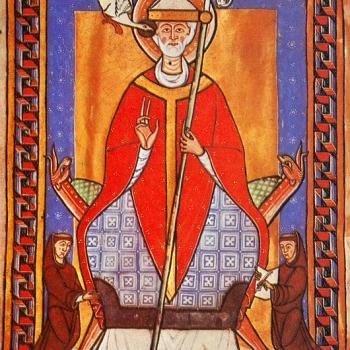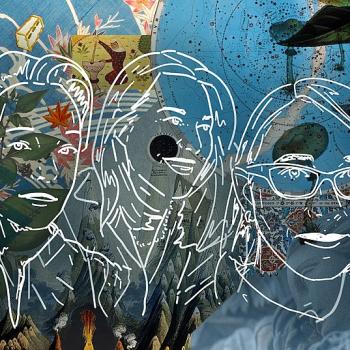Editors' Note: This article is part of the Patheos Public Square on Myth, Imagination, Fairy Tales, and Fantasy. And Faith. Read other perspectives here.
George Eliot's classic novel Middlemarch (1871-72) includes a tragicomic character, Edward Casaubon, who hopes to produce a Key to All Mythologies, explaining the underlying themes that unite all the world's myths and legends, ancient and modern. Casaubon is a plodding scholar, and his project never even comes close to completion. Since life sometimes imitates art, a real-life Casaubon arose in the next generation, the anthropologist James Frazer, whose Golden Bough originally appeared in 1890 and then expanded to twelve volumes for its comprehensive 1915 edition.
Frazer cast a wide net over many customs and many cultures, examining everything from coronation ceremonies to ritual nail clipping. But he was particularly interested in Dying God myths, stories told around the world about the god who must die in order to redeem the people or to restore their blighted lands. Frazer saw Osiris in Egyptian myth, Balder in Norse legend, and Christ on the cross all personifying the cycles of nature — vegetation that arises every spring, flourishes in the summer, fades in autumn, then dies in winter.
Frazer's study of myths, legends, and rituals was certainly one of the most influential books of its era. It helped shape the thought of Sigmund Freud, Carl Jung, and Emile Durkheim, and it begat a whole new school of anthropology. The Golden Bough was equally influential in modern literature, alluded to in 20th-century classics as diverse as T. S. Eliot's "The Wasteland," W. B. Yeats' "Sailing to Byzantium," and James Joyce's Ulysses. Though these monuments of Modernism now appear mainly on the syllabi of college literature courses, The Golden Bough had a very different effect on two Christian fantasy writers whose works continue to sell millions of copies a year: C. S. Lewis and J. R. R. Tolkien.
C. S. Lewis was born near Belfast in 1898 and was reared in a Christian household. But his mother died when he was only nine, and his father was a rather blustery Protestant whose religious views seemed more political than spiritual. When Lewis went off to a series of English boarding schools, he gradually put away childish things, including the perfunctory churchgoing of his youth. In his early teens, Lewis gathered from the social sciences that Christianity, like other world religions, was not a revelation of truth but rather an expression of the deep-felt human need to impose some meaning and purpose upon an otherwise pointless existence.
Through most of his teens and twenties, Lewis wavered between a restless agnosticism and an angry atheism, raging at a god who didn't have decency to exist. But when he took up his studies at Oxford after World War I, Lewis began to meet well-read and intelligent people of faith — Neville Coghill, Hugo Dyson, and most especially, J. R. R. Tolkien. Tolkien had also lost in his mother in his youth, but remained fiercely loyal to her Roman Catholic faith. Lewis and Tolkien discovered that they had much in common — a love of languages, of myths and fairy tales, even specific authors such George MacDonald and Beatrix Potter.
But there was a great divide between them, Tolkien's devout faith versus Lewis's irreligion. Their many conversations on the subject came to a head in October 1931, as Lewis and Tolkien, along with their mutual friend Hugo Dyson, strolled along Addison's Walk in Oxford, discussing myth, romance, and religion. Lewis took the Frazer line he had learned in school, that Christianity was just one dying god myth among many. But Tolkien and Dyson reframed the issue, arguing that the very universality of the story was an important clue to the meaning of things: humans seem to have some inborn awareness of a need for redemption from above. They saw the Incarnation as a pivotal point in human history, when mythical intuitions turned into historical realities. For Lewis, this line of thought was a kind of epiphany, and he further developed the argument in "Myth Became Fact" (1944), published in God in the Dock.
Soon after this watershed moment in their relationship, Tolkien composed a poem for Lewis on "Mythopoeia" (Myth Making), underscoring the idea that myths can contain glimmers of divine truth falling upon human imagination. He added that one of the highest expressions of the imago Dei in humans was for them to become Sub-Creators, to fashion fictional worlds with their own histories, legends, and epic heroes, an imaginative homage to the Creator of the primary world in which we live.
Tolkien's Hobbit (1937) and Lord of the Rings epic (1954-1955) are part of a much larger imaginative project, an attempt to create an entire "legendarium," as Tolkien called it. Tolkien greatly admired the Icelandic Eddas and the Finnish Kalevala, and he hoped to create a similar collection of heroic tales, myths, legends, and poems for his beloved England. Tolkien was someone who studied myth, who believed in the underlying realities it pointed to, and who wanted to create an entire mythology of his own.




